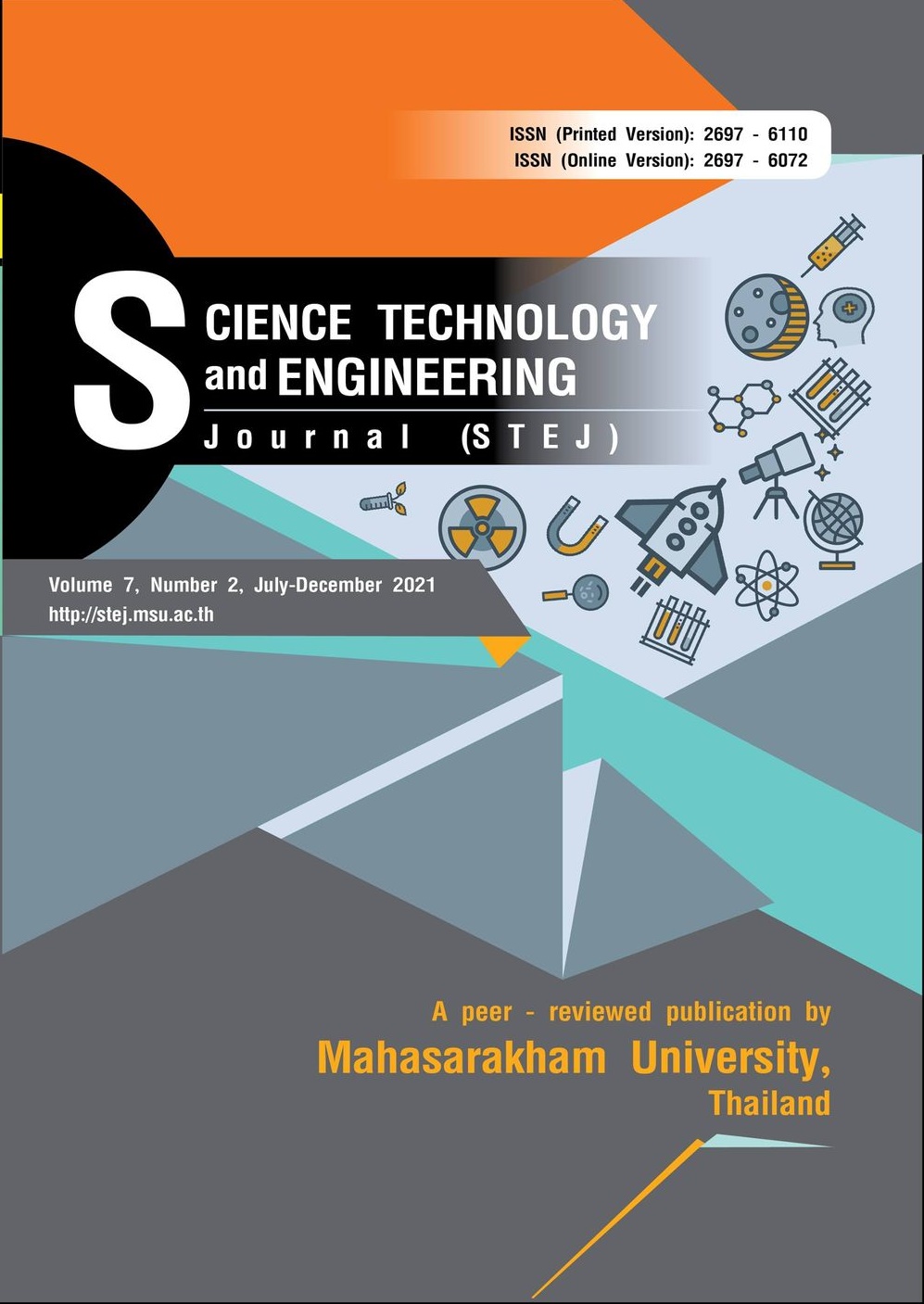Inhibitory Effect Of Bacillus Subtilis P5-6 Against Staphylococcus Aureus On Different States Of Medium
Keywords:
Bacteriocin, solid medium, liquid mediumAbstract
The aim of this research was to investigate the inhibitory effect of Bacillus subtilis P5-6 against Staphylococcus aureus on different states of standard medium with the presence of sodium chloride at high concentration, to develop an effective protective culture in food. Halophile Bacillus subtilis P5-6 isolated from Plara (Thai traditional salt fermented fish) contained both the genes encoding subtilin (spaS) and subtilosin (sboA). Only subtilosin gene expression was detected along with housekeeping gene BA-rpoB when co-cultured with Staphylococcus aureus. With the spot on lawn assay, cell suspension from the P5-6 culture showed inhibitory effect against Staphyloccus aureus, while no inhibition was observed when cell free supernatant was used. In liquid co-culture, the inhibitory effect of P5-6 on Staphylococcus aureus was observed when its inoculum size (population density of 8 log CFU/ mL ) was double that of S.aureus. In solid medium, Bacillus subtilis P5-6 could exert higher antagonistic action against this target pathogen. Bacillus subtilis P5-6 displayed an inhibitory effect even when its population was 2 log CFU/ mL lower than that of Staphylococcus aureus. Solid state cultivation with the presence of sodium chloride could enhance production and/or activity of bacteriocin of P5-6. The observation reflects an importance of the self-inhibitory effect as found in liquid and solid medium cultivation system. The data obtained could be fundamental importance in bacteriocin production development and application of protective culture from P5-6 to protect food against Staphyloccus aureus – one of the most common cause of foodborne disease.
References
Balaban, N. & Rasooly, A. (2000). Staphylococcal enterotoxins. International Journal of Food Microbiology, 61 (1), 1-10.
Ben Said, L., Gaudreau, H., Dallaire, L., Tessier, M. & Fliss, I. (2019). Bioprotective Culture: A New Generation of Food Additives for the Preservation of Food Quality and Safety. Industrial Biotechnology, 15, 138-147.
Castro, A., Silva, J. & Teixeira, P. (2018). Foodborne Diseases. Academic Press.
Chhetri, V., Prakitchaiwattana, C. & Settachaimongkon, S. (2019). A potential protective culture ; halophilic Bacillus isolates with bacteriocin encoding gene against Staphylococcus aureus in salt added foods. Food Control, 104, 292-299.
Chuayjum, C., Onsaard, W. & Prakitchaiwattana, P. (2020). Sugar Conversion of Immature Green Rice Syrup under Solid State Fermentation. Science Technology and Engineering Journal, 6 (1), 46-56.
Gonzalez, D. J., Haste, N. M., Hollands, A., Fleming, T. C., Hamby, M., Pogliano, K., Nizet, V. & Dorrestein, P. C. (2011). Microbial competition between Bacillus subtilis and Staphylococcus aureus monitored by imaging mass spectrometry. Microbiology, 157, 2485-2492.
Kadariya, J., Smith, T.C. & Thapaliya, D. (2014). Staphylococcus aureus and Staphylococcal Food-Borne Disease: An Ongoing Challenge in Public Health. BioMed Research International. Kaplan, H.B. & Greenberg, E.P. (1985). Diffusion of autoinducer is involved in regulation of the Vibrio fischeri luminescence system. Journal of Bacteriology, 163, 1210-1214.
Ko, K.S., Kim, J.W., Kim, J.M., Kim, W., Chung, S.I. & Kim, I.J. (2004). Population structure of the Bacillus cereus group as determined by sequence analysis of six housekeeping genes and the plcR gene. Infection and Immunity, 72, 5253-5261.
Liu, Q., Gao, G., Xu, H. & Qiao, M. (2012). Identification of the bacteriocin subtilosin A and loss of purL results in its high-level production in Bacillus amyloliquefaciens. Research in Microbiology, 163, 470-8.
Muslim, S. (2013). Comparative study between liquid state fermentation and solid state fermentation for production of endo-1, 4-betaxylanase by Bacillus licheniformis. Journal of American Arabic Academy for Sciences and Technology, 4 (11), 131-146.
Oakley, B.R. (2017). Aspergillus nidulans, Reference Module in Life Sciences. Elsevier. Rio, D.C. (2014). Reverse transcriptionpolymerase chain reaction. Cold Spring Harbor Protocols, 11, 1207-1216.
Rutherford, S.T. & Bassler, B.L. (2012). Bacterial quorum sensing: its role in virulence and possibilities for its control. Cold Spring Harbor Perspectives in Medicine, 2 (11), a012427.
Sanders, E.R. (2012). Aseptic laboratory techniques: plating methods. Journal of Visualized Experiment, (63), e3064.
Tagg, J.R. & Mc Given, A.R. (1971). Assay system for bacteriocins. Journal of Applied Microbiology, 21, 943-949. Vaughan, V.C. (1984). Poisonous or “sick” cheese. Public Health, 10, 241-245.
Velho, R.V., Basso, A.P., Segalin, J., Costa-Medina, L.F. & Brandelli, A. (2013). The presence of sboA and spaS genes and antimicrobial peptides subtilosin A and subtilin among Bacillus strains of the Amazon basin. Genetics and Molecular Biology, 36 (1), 101-104.
Wei, Y., Perez, L.J., Ng, W.L., Semmelhack, M.F. & Bassler, B.L. (2011). Mechanism of Vibrio cholerae autoinducer-1 biosynthesis. ACS Chemical Biology, 6, 356-365.
Yan, Z., Ai, X., Su, Y., Liu, X., Shan, X. & Wu, S. (2016). Intracellular biosynthesis of fluorescent cdse quantum dots in Bacillus subtilis: a strategy to construct signaling bacterial probes for visually detecting interaction between Bacillus subtilis and Staphylococcus aureus. Microscopy and Microanalysis, 22 (1), 13-21.
Zhao, S., Hu, N., Huang, J., Liang, Y. & Zhao B. (2008). High-yield spore production from Bacillus licheniformis by solid state fermentation. Biotechnology Letters, 30 (2), 295-297. doi: 10.1007/s10529-007-9540-1.
Downloads
Published
How to Cite
Issue
Section
License
Copyright (c) 2021 Science Technology and Engineering Journal (STEJ)

This work is licensed under a Creative Commons Attribution-NoDerivatives 4.0 International License.







